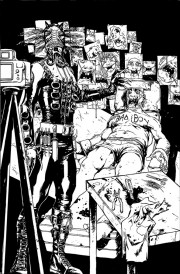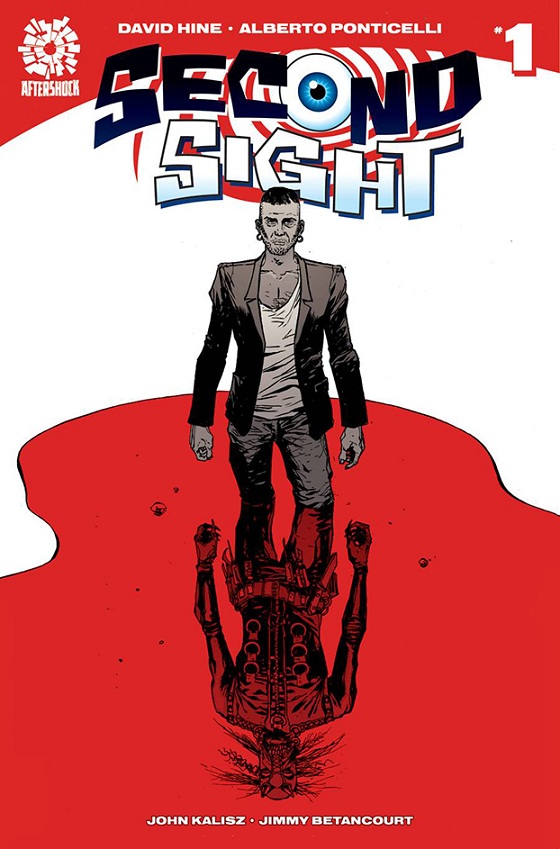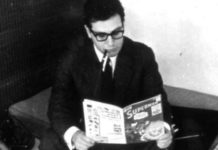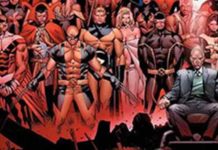David Hine: I’m touching on several of my favourite genres: horror, crime and the supernatural thriller. The story focuses on the character Ray Pilgrim, who, as the title suggests, has genuine psychic powers, which kick in after he takes a hit of very special magic mushrooms. I’ve set the story in two time periods, the early 1990s and the present day. When Ray uses his paranormal ability he finds himself drawn towards evil and ends up literally in the minds of serial killers. That’s useful to the police and in the nineties he became something of a celebrity as a psychic detective until something went horribly wrong.
In the present day, Ray is struggling to connect with his estranged daughter, Toni. He has spent decades avoiding publicity but Toni has inherited his vocation for hunting evil. In her case she is using the internet to expose a ring of child-abusers who are made up of powerful and influential members of the British establishment. As the story unfolds we become aware of the link between the events of the two time-periods. A key element is the contrast between today’s generation of tech-savvy teenagers, who live with social media, cell phones and the incessant stream of information that flows from the internet, and the nineties, when Ray had to walk to the end of the road to use a public phone box and news came from the television or a newspaper. Ray in the nineties was not much older than Toni is now and we’ll see that once they get past their conflicts, they actually have a lot in common. They are both smart, rebellious and unconventional. And they both wear a lot of black.
D.H.: I’ve always written material that challenges our definitions of good and evil. The Darkness was actually a perfect metaphor for the dark forces inside all of us and the struggle to stay true to our humanity in the face of that evil. I’m continuing that theme here. The horrors are often quite physical – there will certainly be a lot of blood spilled – but it’s equally about psychological abuse and no one is going to come out of this with clean hands or a clean conscience.
It’s great to be able to set this book in London – my home territory! Most of my comic book work has been for the US market and I usually have to set the stories there – New York, L.A. Las Vegas. I was very pleased to get a positive response when I asked my editor, Mike Marts, if he would be okay with a London setting. The scenes in the squat are very much based on my own experience of squatting when I first moved to London with no money for rent. I’m sending Alberto lots of reference pictures so the background detail is authentic.
As for influences, I guess The Silence Of The Lambs and Red Dragon by Thomas Harris, then The Killer Inside Me by Jim Thompson and even Crime and Punishment by Dostoevsky and The Stranger by Albert Camus. All those books were about getting inside the heads of killers, trying not just to understand, but also to feel what it’s like to lose your moral compass and be consumed by evil. Those examples are all novels and I think literature is the main sources of plot and theme. As far as storytelling and style, I guess José Munoz is still my biggest influence along with Richard Corben. I also loved Eduardo Risso’s work on 100 Bullets and of course Brian Azzarello’s hardcore writing on the same book.



D.H.: I have had a couple of other creator-owned books since The Bulletproof Coffin. There’s Storm Dogs, which is a science-fiction noir, with art by Doug Braithwaite, which was also from Image Comics, and I have a horror story called The Bad, Bad Place drawn by Mark Stafford, running currently in the British bi-monthly anthology Meanwhile. But Second Sight is one that I’ve been working on periodically for a very long time. I have three or four concepts that I’m developing at the moment and I had been thinking about approaching a few publishers, like Boom! Studios, for instance. Mike Marts actually contacted me at the perfect time. I didn’t know that he was setting up an independent company until he emailed me and asked to pitch. I sent the three outlines that I had been developing and he jumped on Second Sight.
I have a great relationship with Mike. When I was first asked to work for Marvel, Joe Quesada gave my horror book Strange Embrace to a couple of editors and Mike was one of the first to approach me to write for him, based on that book. The work I’ve done with him since then has been some of my best mainstream work. The first was District X and later I wrote several Batman books for him, including the Arkham Reborn series. They were successful in their way but this feels like the book that we were meant to do together. There are similar elements of psychological horror to those in Strange Embrace. It’s very cool to be doing a book that doesn’t have the constraints of working with an existing character. There have been a couple of times where I’ve asked Mike if he’s okay with something and he just reminds me that this is my book. We’re in indie territory now so it’s all down to me and Alberto.
D.H.: Before I pitched to AfterShock, I had been in contact with Peter Snejbjerg, who liked the concept but wasn’t able to take on a long project because of other commitments. Mike had a checklist of artists, mostly people he has worked with previously at Marvel and DC and he suggested Alberto. I knew his work from DC comics like Dial H and Frankenstein, Agent of S.H.A.D.E. so I knew he would be the right fit. He has been a dream to work with. He totally gets the mood and the characters and he’s really knocking it out of the park with the detail he is putting into the scenes. I’m not sure if Alberto has ever been to London, but his depiction of the city is dead on. I should also give a shout to John Kalisz, whose colours are really bringing the art to life.
I’m incredibly happy to be part of AfterShock. It really feels like a team effort, from the editorial side to the artists, designer, letterer, and of course my fellow creators who are coming up with such amazing new books. It’s a very diverse and original package of titles and I think the fans are as excited as we are to see what the new kid on the block is going to do next.
![]() AfterShock Comics
AfterShock Comics
![]() Interview with Brian Azzarello in Zona Negativa.
Interview with Brian Azzarello in Zona Negativa.
![]() Interview with Garth Ennis in Zona Negativa.
Interview with Garth Ennis in Zona Negativa.
![]() Interview with David Hine in Zona Negativa.
Interview with David Hine in Zona Negativa.
![]() Interview with Justin Jordan in Zona Negativa.
Interview with Justin Jordan in Zona Negativa.
![]() Interview with Amanda Conner and Jimmy Palmiotti in Zona Negativa.
Interview with Amanda Conner and Jimmy Palmiotti in Zona Negativa.
![]() Interview with Mike Marts in Zona Negativa.
Interview with Mike Marts in Zona Negativa.









